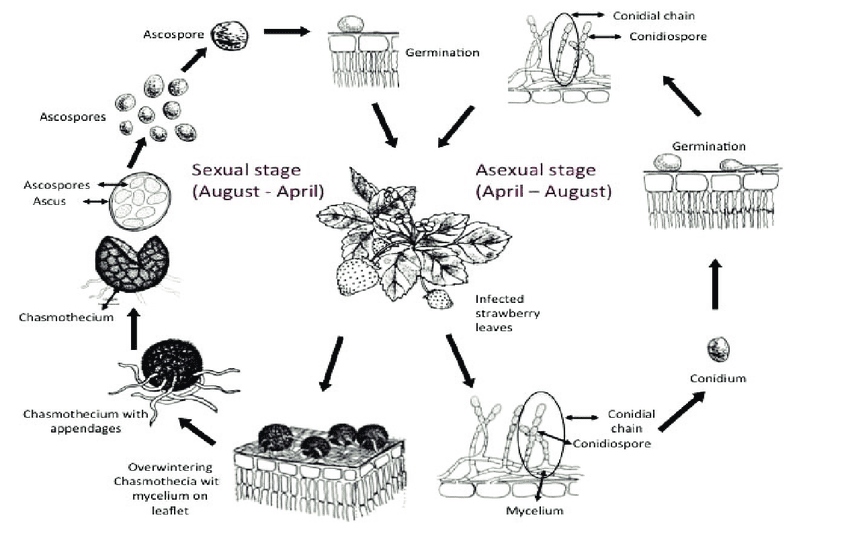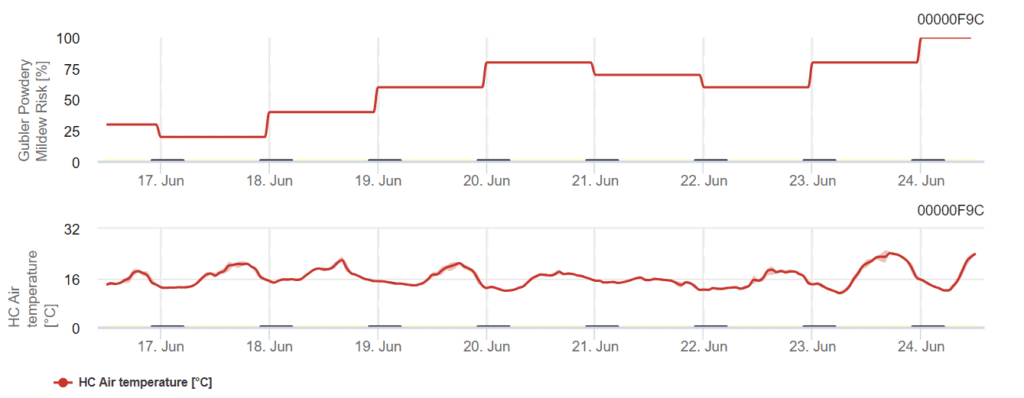
Fragola modelli di malattia
Antracnosi
Agente patogeno
L'antracnosi delle fragole, causata da Colletotrichum acutatumSi manifesta con lesioni nere e infossate su fusti, steli e frutti. Questa malattia fungina colpisce tutte le parti della pianta, compresa la chioma, le radici, i piccioli e gli steli.
La malattia può svilupparsi rapidamente in condizioni favorevoli, con fino a 90% dei frutti potenzialmente infetti entro una settimana o meno. Sia i frutti immaturi che quelli maturi sono suscettibili all'infezione, ma la malattia è più diffusa nei frutti in maturazione o completamente maturi. Le piante infette o i detriti vegetali possono fungere da fonti di inoculo per lo svernamento. In primavera, le spore vengono prodotte e disperse dalla pioggia e dal vento su distanze relativamente brevi.
Il patogeno entra nella pianta attraverso un appressorio, che penetra nella cuticola e invade le cellule epidermiche. Inizialmente, C. acutatum Il fungo è presente in una fase biotrofica e passa a una fase necrotrofica, in cui prolifera all'interno delle cellule morte. Con il progredire della malattia, il fungo forma strutture di acervuli sotto le pareti cellulari epidermiche. Questi acervuli maturano e rilasciano conidi, che diffondono la malattia più rapidamente, soprattutto in caso di pioggia. I conidi secondari rappresentano anche una fonte di inoculo importante.
Sintomi
I sintomi si manifestano dapprima con l'appassimento delle foglie più giovani, che possono temporaneamente riprendersi ma presto muoiono. Sulle foglie compaiono macchie nere irregolari, soprattutto sulla punta delle foglioline.
Il tessuto della chioma presenta una colorazione rossastra che alla fine diventa marrone scuro o nera con il deterioramento della pianta. Le chiome infette sono spesso parzialmente danneggiate, con una crescita stentata ma non la morte completa della pianta. In genere si infetta solo un lato della chioma, piuttosto che l'intera corona.
Sui piccioli e sugli steli delle piante da frutto si formano lesioni scure e allungate. I piccioli e gli steli colpiti possono essere avvolti dalle lesioni, causando l'appassimento e la morte delle foglie o di intere piante figlie.
I frutti possono essere infettati in qualsiasi fase dello sviluppo, indurendosi e diventando marroni. Sui frutti maturi si sviluppano lesioni scure e infossate, che portano alla mummificazione anziché alla maturazione. I frutti possono anche apparire ricoperti da masse di conidi di colore rosa o salmone.
Modello FieldClimate
Modello generale di antracnosi
Sensori necessari:
- Temperatura dell'aria
- Bagnatura delle foglie
C. acutatum infetta le piante a temperature comprese tra 15°C e 30°C, ma è necessario un periodo di bagnatura fogliare di lunga durata. A temperature ottimali comprese tra 20°C e 25°C, è necessario un periodo di bagnatura fogliare di 12 ore. Quando il grafico dell'infezione raggiunge 100%, in campo si verificano le condizioni ottimali per un'infezione.
Letteratura
- Aljawasim, B. D., Samtani, J. B., & Rahman, M. (2023). Nuove intuizioni nel rilevamento e nella gestione delle malattie da antracnosi nelle fragole. Plants, 12(21), 3704.
- Ellis, M. A., & Erincik, O. (2008). Antracnosi della fragola. L'Estensione dell'Università dello Stato dell'Ohio.
- Smith, B. J. (2008). Epidemiologia e patologia dell'antracnosi della fragola: una prospettiva nordamericana. HortScience, 43(1), 69-73.
Oidio
Agente patogeno

L'agente patogeno dell'oidio nelle fragole è Podosphaera aphanis. Sverna in due forme: micelio e cleistoteci.
Il micelio svernante si attiva in primavera, producendo conidiofori che, una volta maturi, rilasciano conidi (spore riproduttive asessuate). I conidi atterrano su un nuovo tessuto, germinano e formano le appressorie, strutture specializzate per l'infezione che penetrano nelle cellule vegetali. Il processo porta alla formazione di nuove colonie.
La Cleistothecia rilascia ascospore (spore riproduttive sessuali) da marzo a maggio. Le ascospore atterrano anche su nuovi tessuti, germinano e formano nuove colonie.
Sia il micelio che i conidi fungono da inoculo primario. Le infezioni secondarie avvengono per lo più attraverso i conidi, che vengono dispersi dal vento e si diffondono rapidamente.
Quando le condizioni ambientali diventano meno favorevoli, il fungo passa alla riproduzione sessuale - formazione di cleistoteci - e il ciclo si ripete quando gli inoculi svernano.
Sintomi
Le macchie polverose bianche di miceli e conidi compaiono su tutte le parti aeree e si aggregano, ricoprendo l'intera superficie. Gli organi giovani sono più sensibili di quelli vecchi. Per quanto riguarda le foglie, la parte superiore presenta un oidio maggiore rispetto alla parte inferiore. Le infezioni gravi causano una riduzione della fotosintesi, la defogliazione e la deformazione dei frutti. Con lo sviluppo della malattia, la foglia si arriccia verso l'alto e si formano macchie da viola a rossastre sulla superficie fogliare.
Modelli FieldClimate
Modello Gubler modificato da Broome
Sensori necessari:
- Temperatura dell'aria
Il modello si basa sul quadro di Gubler con modifiche alle soglie di alta temperatura introdotte da Broome. Calcola il rischio con la temperatura dell'aria e l'indice di rischio varia da 0 a 100. Per attivare l'indice sono necessari tre giorni consecutivi con oltre 6 ore di temperature tra 21°C e 30°C. Per far scattare l'indice sono necessari tre giorni consecutivi con oltre 6 ore di temperature comprese tra 21°C e 30°C.
L'indice aumenta di 20 punti per ogni giorno che soddisfa queste condizioni (un minimo di 6 ore a 21°C a 30°C). Al contrario, se una giornata trascorre meno di 6 ore in questo intervallo di temperatura o se la temperatura supera i 35°C, l'indice diminuisce di 10 punti.

Il modello originale di Gubler stabiliva una soglia di 35°C per 0,35 ore, ma Broome ha introdotto diverse soglie dettagliate per le alte temperature. Quando vengono raggiunte temperature specifiche (34°C, 36°C e 38°C) per una durata sufficiente, vengono sottratti punti. Inoltre, il modello tiene conto del ritardo nella crescita fungina; qualsiasi aumento dell'indice nel giorno successivo viene ritardato di diversi giorni e vengono sottratti cinque punti in più per ogni giorno di ritardo.
Un indice inferiore a 30 indica un tasso di riproduzione di 15 giorni o meno, mentre un indice di 40~50 è considerato normale e implica un tasso di riproduzione di 8-11 giorni. Un indice superiore a 60 indica che il patogeno si riproduce ogni 5 giorni e si consiglia di ridurre l'intervallo di irrorazione.
Modello di muffa polverosa delle fragole
Sensori necessari:
- Temperatura dell'aria
- Umidità relativa
- Bagnatura delle foglie
Questo modello include l'umidità fogliare e l'umidità relativa in un altro modello. Le temperature dell'aria superiori a 21°C e l'umidità relativa superiore a 66% aumentano il rischio, mentre le temperature più basse, l'umidità relativa e la bagnatura delle foglie lo diminuiscono.
L'indice di rischio inferiore a 60 indica misure di protezione delle piante di basso livello, mentre il rischio superiore a 60 indica un aumento del rischio di malattia e si raccomanda l'irrorazione. Rischi di malattia pari a 100 per un periodo più lungo richiedono un aumento della densità di applicazione.
Letteratura
- Broome, J. C., Hand, E. K., Backup, P., Janousek, C. N., & Gubler, W. D. (2010, giugno). Revisione della soglia di alta temperatura per l'indice di rischio di oidio della vite di Gubler-Thomas. In PHYTOPATHOLOGY (Vol. 100, No. 6, pp. S17-S18). 3340 PILOT KNOB ROAD, ST PAUL, MN 55121 USA: AMER PHYTOPATHOLOGICAL SOC.
- Gadoury, D. M., Asalf, B., Heidenreich, M. C., Herrero, M. L., Welser, M. J., Seem, R. C., ... & Stensvand, A. (2010). Iniziazione, sviluppo e sopravvivenza dei cleistoteci di Podosphaera aphanis e loro ruolo nell'epidemiologia dell'oidio della fragola. Fitopatologia, 100(3), 246-251.
- Jin XiaoLei, J. X., Fitt, B. D. L., Hall, A. M., & Huang YongJu, H. Y. (2013). Il ruolo dei chasmothecia nell'avvio delle epidemie di oidio (Podospheara aphanis) e il ruolo del silicio nel controllo delle epidemie su fragola.
- Palmer, S. A. (2007). Oidio della fragola: epidemiologia ed effetto della nutrizione dell'ospite sulla malattia (tesi di dottorato).
- Aldrighetti, A., & Pertot, I. (2023). Epidemiologia e controllo dell'oidio della fragola: una rassegna. Phytopathologia Mediterranea, 62(3), 427-453.
Attrezzatura consigliata
Verificare quale set di sensori è necessario per monitorare le potenziali malattie di questa coltura.
